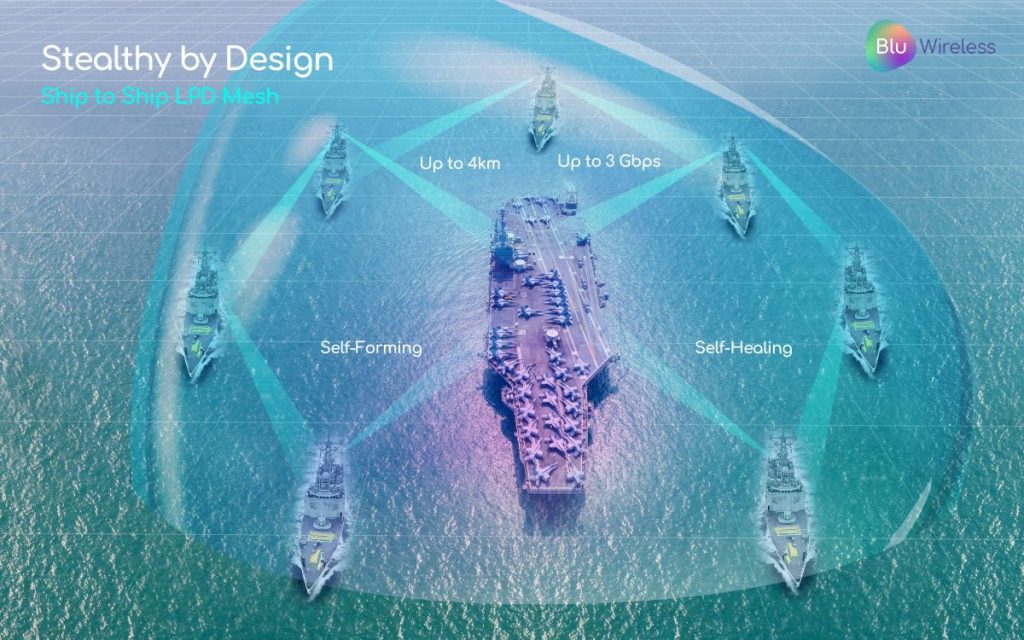The Evolving Nature of Tactical Communications
by Macy Summers
This article was first published on the Battlespace website.
Russia has been facing numerous administrative and logistical problems during their invasion of Ukraine. One significant problem has been connectivity, or lack thereof. According to RUSI, reports suggest that radio communications across the Russian forces are poor, leading to makeshift solutions including the use of unencrypted high frequency (HF) radio for long-range communications and mobile phones to communicate.
The use of such networks for military purposes is challenging due to the high probability of signal detection and a significant electromagnetic footprint. The centralised nature of commercial 5G 3GPP networks, although offering high speeds and range, also means that the whole network will fail should the central node core network be destroyed or jammed.
IEEE 5G mmWave networks on the other hand are self-healing, which means if a node is destroyed, the network re-configures to maintain full connectivity by another node stepping in to complete the circuit network.
In this article, we’ll explore why 5G mmWave technology presents a step change in modern tactical connectivity, offering superior self-healing and Low Probability of Detection (LPD) capabilities.
From voice connectivity to digital fires
In the past, tactical networks that could re-configure (self-heal) themselves were limited to long range and speeds of only megabits per second so they were suitable for asymmetric warfare where voice was the primary application.
We’re now in an age of potential near-peer, large scale conflicts where forces need substantially more than voice connectivity. They need real-time video sensors, with tactical formations commanders needing to have access to a Common Operating Picture – to see what’s the status of supplies, and to be able to call for digital fires.
Furthermore, if they need artillery support, air support, drones, or protection, they should ideally be able to utilise a self-healing gigabit network that is also WAN-connected via satellite or airborne drone relay back to the Command-and-Control network.
The anatomy of a mesh network

Self-healing mesh networks are particularly suited to enabling sophisticated communications at the tactical edge.
Mesh networks are made up of a series of interconnected nodes. These nodes are wireless radio devices that communicate with one another, creating an overlapping mesh that does not rely on a central hub. This allows for quick and efficient data routing.
Nodes are self-sufficient and self-managed, finding the fastest and most reliable paths using Line of Sight (LOS) wireless communications to transfer data at faster rates. The more nodes there are, the further the connection spreads, creating a wireless web of connectivity that can serve large areas.
Innovative mesh networks, such as the VxLAN (Virtual extensible LAN) instantiation delivered by PhantomBlu, allow the network to be sized up to millions of simultaneous nodes delivering superior network scalability.
Towards step change in mmWave mesh connectivity
Traditional IEEE networking utilises a centralised hub and a client. Very recent innovation by Blu Wireless in this space now allows every node to be either a hub or a client. The industry calls this ‘gender changing’. In practice, this means that if the hub gets disabled, the software keeps track of all the other nearby nodes, and one of the network clients can step up and become a hub in about a tenth of a second. This ability to change genders is unique and groundbreaking in the IEEE space.
Such a configuration means that peer-to-peer mesh networks can support modern day tactical formations and their connectivity needs (as long as Line of Sight is maintained between the nodes) in an extremely powerful way.
The feedback we’re getting from customers on this innovation has been phenomenal because it’s a step change in the level of mmWave LPD self-healing unseen before.
LPD mesh networking supports the shift towards mobile command posts

Self-healing is just one important part of the equation though. The last bit of the puzzle is LPD (Low Probability of Detection) capability that allows tactical forces to maintain an element of surprise and project force.
The Blu Wireless PhantomBlu mmWave tactical network provides LPD with speeds of over 1 gigabit per second. This is because it utilises the V-band at 57-71 GHz which is an unlicensed mmWave radio frequency band with the unique capability of being LPD by its very physics nature.
When it comes to tactical communications, Western militaries are developing a shift towards mobility, with tactical groups knowing they have to be continuously on the move to avoid being detected and targeted with precision weapons. If they stop, they are readily detected – and V-band or Free Space Optical (FSO) technology are the only exceptions.
mmWave technology is designed for mobility enabling on-the-move wireless communications at highway speeds and above. The technology is also set to enable Command Posts (CP) of the future that will communicate seamlessly on the move, permit digital Pad-based mobile CPs persistently connected to Division/BCT C2 and one’s forces. Finally, mmWave also delivers a stealthy, scalable, high performance gigabit tactical network with self-healing capabilities.
If you’re interested in the PhantomBlu Family, download the Product Brief or get in touch.
